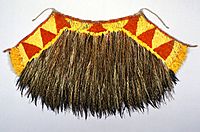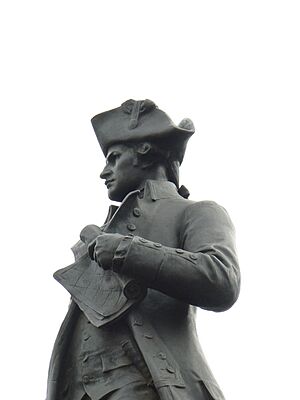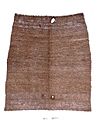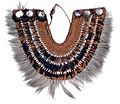James Cook Collection: Australian Museum facts for kids
The Australian Museum has a special collection called the Cook Collection. It was brought to the museum in 1894. This collection includes 115 amazing objects. These items were gathered during Captain James Cook's three big trips across the Pacific Ocean. These voyages happened between 1768 and 1780.
Many of these objects are ethnographic artifacts. This means they are items made and used by different cultures. They were collected when Pacific Peoples first met Europeans. Most of the documents and other items related to the voyages were moved to the Mitchell Library in 1935. The collection stayed with Captain Cook's family until 1886. Then, it was bought by the New South Wales Government and later given to the Australian Museum.
Who Was James Cook?
Captain James Cook (born 1728, died 1779) was a famous British explorer. He was also a skilled navigator and mapmaker in the Royal Navy. Cook created detailed maps of Newfoundland. Later, he made three important journeys to the Pacific Ocean.
During these trips, he was the first European to reach the eastern coast of Australia. He also discovered the Hawaiian Islands. Cook was also the first to record a full trip around New Zealand.
Cook's Early Life and Voyages
Cook joined the British merchant navy when he was a teenager. In 1755, he joined the Royal Navy. He fought in the Seven Years' War. He also mapped the entrance to the Saint Lawrence River during the siege of Quebec. This work caught the attention of the British Admiralty and the Royal Society.
Because of his skills, Cook was chosen in 1768 to command the ship HM Bark Endeavour. This was for the first of his three Pacific voyages.
Mapping the World
On his three voyages, Cook traveled thousands of miles. He explored many unknown parts of the world. He mapped lands from New Zealand to Hawaii in great detail. He named new places and recorded islands and coastlines on European maps. Cook was known for his excellent sailing, mapping skills, and bravery. He was also a strong leader for his crew.
Cook's Legacy and Impact
Captain Cook was killed in Hawaii in 1779 during a misunderstanding with Hawaiians. He left behind a huge amount of scientific and geographical knowledge. His work influenced explorers for many years. There are many memorials to him around the world.
However, his role in opening up the Pacific to colonisation is also discussed. People still debate how his voyages affected the native peoples of these lands.
Where Did the Collection Come From?
The "provenance" of an object means its history and where it came from. The items in the Cook Collection have a fascinating story. They show the different cultures Cook encountered.
Treasures from Hawaii
Captain Cook first arrived in the Hawaiian Islands on January 18, 1778. His ships stayed there for three months. Cook thought these islands were his most important discovery for England. He named them the Sandwich Islands.
The Hawaiians first treated Cook like a god. They gave him valuable gifts. These included beautiful feathered capes, hats, and ornaments. This was a first meeting between Europeans and Hawaiians. A lot of trading happened. Many items, especially things worn or carried, were brought back to England. Hawaiian featherwork from Cook's voyages shows how amazing these crafts were.
Cook's ships returned to Hawaii almost a year later. After some time, they left but had to return due to a ship problem. On February 14, 1779, Cook was killed in Hawaii due to a misunderstanding.
The Hawaiian items in the Australian Museum's Cook collection include:
- A feathered cloak
- Four feathered circlet ornaments
- A mat for a feather cloak
- A woven cane helmet
- A nose whistle
- A shark's tooth ring
- Three tiny carved bone turtles
- A shark's tooth knife
- Over 20 pieces of barkcloth
Exploring North America's Coast
Cook's ships left Hawaii on February 2, 1778. They sailed towards North America. On March 29, they found Nootka Sound. The ships stayed there for about a month for repairs.
A lot of trading took place. Many objects from the North West Coast came from Nootka Sound. Wooden combs were a common item collected.
Their next stops were Prince William Sound and Cook Inlet. The items collected here were very mixed. They included objects from the Tlingit people and Athabaskan groups. Cook noticed that no one lived in the bay where they anchored. Containers made of mountain sheep horn were collected.
In Unalaska (part of the Aleutian Islands), the crew traded cloth from Hawaii and Tahiti. They exchanged it for arrows and other items from the locals. Only a few objects can be directly linked to Cook's voyages. Small ivory birds, possibly game pieces, were likely collected in Unalaska. Many weapons, fishing tools, and canoe models were collected in northern America and Asia. It is hard to know exactly where each one came from.
Discoveries in New Caledonia
Cook visited New Caledonia for two weeks in 1774 during his second voyage. He spent eight days in the Balad area. There, Cook took part in a special exchange of gifts. Not many items were collected, mostly weapons. The local people were happy to trade these.
New Caledonian hardwood clubs were beautifully carved and polished. The Australian Museum's collection has three spearthrowers. One of these is decorated. It also holds one of three knitted bags for slingstones. Two combs are also part of the collection.
New Zealand's Unique Items
Before Cook, only Abel Tasman had briefly visited New Zealand in 1642. On October 8, 1769, Cook's ship, the HMS Endeavour, anchored in a bay. This was the first meeting between Europeans and the local Māori people. The interactions were not peaceful at first. Cook named the area Poverty Bay.
However, the Endeavour then sailed around both the North and South Islands. They met many different Māori groups and traded goods. French ships also visited New Zealand in 1769 and 1772. Cook's ships returned on his second (1773) and third (1777) voyages. Over time, the availability of iron tools and European ideas might have changed how artifacts were made.
Since this collection came from Cook's widow, it was likely personal to Cook. So, it's hard to say exactly which voyage or area each item came from. Many types of artifacts were collected from New Zealand during Cook's voyages. These included over 40 cloaks, many body ornaments, feather boxes, and musical instruments.
Many weapons were collected, but this collection only has one stone club. There are also three stone adze blades and two fish hooks. Food preparation tools were rarely collected. This might be because trading happened away from villages, mostly between men.
Adventures in the Society Islands
The island of Tahiti was where Cook first met Pacific Islanders. Other European explorers had visited Tahiti before Cook. Samuel Wallis visited in 1767, and Louis-Antoine de Bougainville in 1768. They traded iron nails and spikes for barkcloth, fish hooks, and other tools. Stories from these trips made Tahiti seem like a paradise.
The Royal Society sent Cook on his first voyage to Tahiti. His mission was to observe the Transit of Venus, an astronomical event. On April 13, 1769, the Endeavour arrived at Tahiti's Matavai Bay. The islanders welcomed Cook and his crew as friends. They gave them gifts of perfumed cloth and fresh food.
Cook named a nearby spot Point Venus. Here, astronomers tried to measure the distance between Earth and the Sun. However, their telescopes weren't precise enough at the time.
Cook and his crew explored Tahiti and the Bora Bora islands. A Tahitian priest named Tupaia guided them. He even traveled with them on the Endeavour to Batavia.
The Endeavour stayed in the Society Islands for three months. Cook's ships returned three more times on later voyages. During these visits, there was constant trading. Iron tools were highly valued. Many objects were collected, and detailed maps were made.
The items collected cannot be linked to one specific island or voyage. Before Cook, there was already a lot of trading between the islands. Joseph Banks, a botanist on Cook's first voyage, enjoyed Tahitian life. He took part in a public dance ceremony with drums and nose flutes. He also saw a mourning ceremony.
The Australian Museum's collection has a shell breast ornament. Semicircular breast ornaments, or gorgets, were often worn. Many were collected as special curiosities. Large pieces of barkcloth were often given as gifts. Much of the collected cloth was cut into samples for books.
Friendly Islands of Tonga
The Tongan islands were visited by other explorers before Cook. Cook's ships visited for a few days in 1773 and again in 1774. He named them the Friendly Islands. He returned on his third voyage in 1777. Iron tools traded during Cook's second voyage led to new carving techniques. These can be seen in wooden items from the third voyage.
Many items were collected from Tonga. Some were even from Fiji and Samoa. This shows that Tongans already traded with their neighbors. Many body ornaments were collected. These include a small ivory human figure and three shell necklaces.
Several kinds of pandanus mats were collected. Many baskets of different styles and materials were also found. The Australian Museum collection does not have examples of fly whisks, food tools, bowls, or musical instruments. However, it does have some fishing equipment. This includes a fish net and 11 fish hooks. Combs made from coconut leaflets were also collected.
Vanuatu's Artifacts
Cook made three landings on his second voyage in Vanuatu. He visited the islands of Malakula, Erromango, and Tanna. He renamed the group the New Hebrides. There was fighting on some islands, except for Tanna. So, most non-weapon items in Cook's collections likely came from Tanna.
Panpipes in the Australian Museum collection are from Tanna. Arrows have also been linked to Vanuatu. Some clubs in other collections might have been gathered during Cook's second voyage.



























































